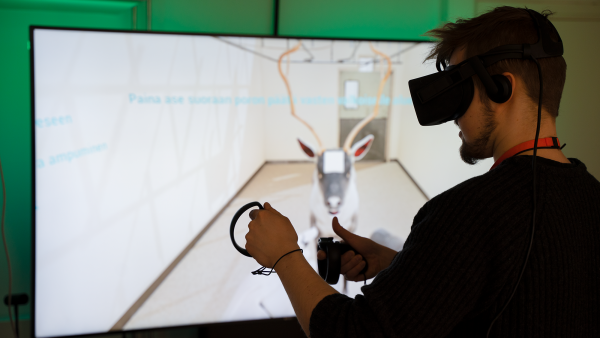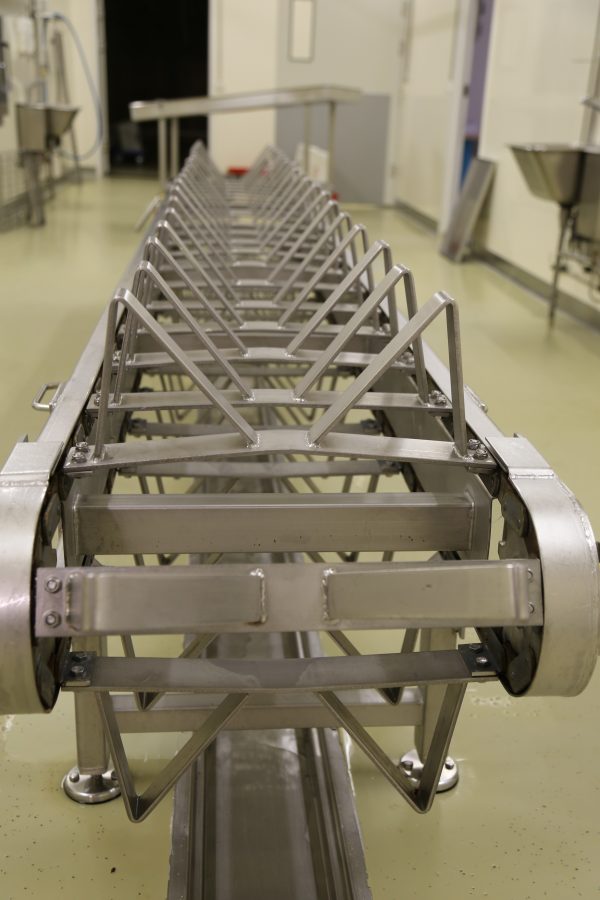Mari Ronkainen, Bachelor of Hospitality Management, Project Planner, Future bioeconomy, Lapland University of Applied Sciences
Slaughtering competence and animal welfare
There are 15 big slaughterhouses, 50 small slaughterhouses, and 19 reindeer slaughterhouses in Finland. Most of the reindeer slaughterhouses are owned by reindeer herders or reindeer herding cooperatives. A few are owned by meat companies. Most of the reindeer are slaughtered by the owners, many of whom have only learned how to slaughter in practice, not at school. Furthermore, reindeer herders are not full-time slaughterers. They nevertheless have great proficiency in slaughtering reindeer. The POROPEDA (“New pedagogical solutions in reindeer herding”) project has arranged training to promote reindeer slaughterer’s competence.
Slaughterhouses are strictly regulated. European Union legislation requires that slaughtering be done in such a way as to optimally protect animals from distress, pain, and suffering. It is important to avoid causing animals stress before slaughtering. Reindeer herders know best the species-typical behaviour of reindeer. They know exactly how to handle reindeer calmly. This is an important part of animal welfare and affects meat quality. Globally, other domestic animals are usually slaughtered by people who work at a slaughterhouse and know little about the particular animal’s behaviour.
In Finland, reindeer slaughtering is done near primary production. This reduces the stress reindeer experience, because the transport distance is shorter. Sometimes, cattle in other countries are even transported to different countries for slaughter. To ensure local food production, the number of slaughterhouses should be increasing.
Virtual Slaughterhouse
Training in slaughterhouses is difficult, whether the new worker knows how to handle animals or not. If a person knows nothing about slaughtering, it is very difficult to get started. There is a risk of doing the work wrongly or too slowly, and these factors are a risk to animal welfare and food hygiene.
The POROPEDA project is creating a new virtual learning environment, Virtual Slaughterhouse. Virtual Slaughterhouse includes three parts: websites with a lot of information about slaughtering, a web slaughterhouse where you can move around in a realistic-looking slaughterhouse and discover more about the different phases of slaughtering, and a VR-game (photo 1) where you can try stunning, sticking (bleeding), and detaching the head of a reindeer. Websites and the web slaughterhouse will be available for everyone at www.virtuaaliteurastamo.fi. For the VR game, certain equipment is required (a VR headset and hands, a gaming PC), and the instructions for obtaining the game for personal use will also be available on the website. At its best, this learning environment can work as a training platform for new slaughterers.

Photo 1. VR slaughtering game. Photo: Tuuli Nivala
Benefits
Lapland is associated with reindeer. It is an important part of the image of Finland. People want to know more about this traditional industry. Virtual Slaughterhouse makes the slaughtering process more transparent for those who know little about it. At its best, this can improve reindeer herding’s and slaughterhouses’ image and develop the whole meat industry.
Virtual Slaughterhouse is a new innovation. Although reindeer herding and slaughtering are not practised globally, Virtual Slaughterhouse can still be utilised extensively. This learning environment can easily be adapted internationally for the slaughter of other animals, for example, sheep. There will be a lot of animated material in the web slaughterhouse so different language versions are unnecessary. People throughout the world can watch animated material and learn from it. The materials are carefully picked and produced to make them subtle, not disturbing or gory.
Virtual Slaughterhouse speaks especially to young people who want to learn how to slaughter. They can learn about the equipment (Photo 2), animal welfare, and safety, and be shown good practices before going to a real slaughterhouse. The young generation is very good with technology, because they use it on a daily basis.
Virtual environment can increase continuity in reindeer husbandry. The Covid-19 pandemic has also made online and distance learning more important than ever. Distances in Northern Finland are long, so asynchronous learning (i.e. location-independent learning) reduces the carbon footprint, because students do not have to go to the same physical location. Learning can happen from home.

Photo 2. A skinning cradle is part of the reindeer slaughterhouse equipment. Photo: Mari Ronkainen
Practical training with a tutor
Virtual Slaughterhouse is a great learning environment for beginners, but it does not replace practical training. Slaughtering is learned in practice after many repeats. Tutoring is the proven teaching method in slaughterhouses. This means a beginner works as a pair with an experienced slaughterer. This method ensures that slaughtering does not take more time than usual, because the tutor helps the beginner throughout the slaughtering. The beginner gradually gains the competence to do the work by themselves.
Source:
Majuri, K. & Muuttoranta, K. 2021. Good practices in reindeer slaughtering – Slaughtering at a slaughterhouse. https://urn.fi/URN:ISBN:978-952-316-394-2. Retrieved on 5 October 2021.
Key words: reindeer herding, slaughtering, animal welfare, virtual learning environment